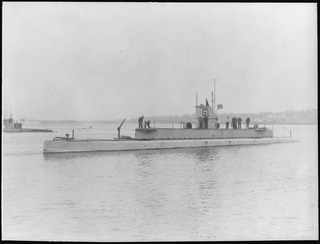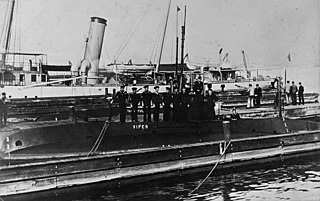
USS Grampus (SS-4), a Plunger-class submarine later named A-3, was the fourth ship of the United States Navy to be named for a member of the dolphin family, Grampus griseus.

The second USS Bainbridge was the first destroyer, also called "Torpedo-boat destroyers", in the United States Navy and the lead ship of the Bainbridge-class. She was named for William Bainbridge. Bainbridge was commissioned 12 February 1903. She served in the Asiatic Fleet before World War I and served in patrol and convoy duty during the war. She was decommissioned 3 July 1919.

USS G-1 (SS-19½) was the lead ship of her class of submarine of the United States Navy. While the four G-boats were nominally all of a class, they differed enough in significant details that they are sometimes considered to be four unique boats, each in a class by herself.

USS Plunger (SS-2) was one of the earliest submarines of the United States Navy. She was the lead boat of her class and was later renamed A-1 when she was designated an A-type submarine. She is not to be confused with the experimental submarine Plunger which was evaluated by the U.S. Navy from 1898 to 1900, but not accepted or commissioned.

The Plunger class was an early class of United States Navy submarines. In the first years of their service, they were used primarily as training and experimental vessels for the newly formed "silent service" to familiarize naval personnel with the performance and operations of such craft. They were known as the "A class" after being renamed to A-type designations on 17 November 1911. All except Plunger ended up being stationed in the Philippines, an American possession, prior to the outbreak of World War I. They were shipped there on colliers and formed an integral part of the harbor defense system for Manila. In some instances, this class of submarines is referred to as the Adder class, as USS Adder was the first boat of the class to be completed.

USS Adder, later renamed A-2, was one of seven Plunger-class submarines built for the United States Navy (USN) in the first decade of the 20th century.

USS Moccasin (SS-5) was one of seven Plunger-class submarines built for the United States Navy (USN) in the first decade of the 20th century.

The first USS Pike (SS-6) was a Plunger-class submarine in the service of the United States Navy, later renamed as A-5.

USS Shark (SS-8) was the third vessel of the U.S. Navy to bear the name. She was an early Plunger-class submarine in the service of the United States Navy, later renamed as A-7.

The United States Navy Salmon-class submarines were an important developmental step in the design of the "fleet submarine" concept during the 1930s. An incremental improvement over the previous Porpoise class, they were the first US submarine class to achieve 21 knots with a reliable propulsion plant, allowing them to operate with the Standard-type battleships of the surface fleet. Also, their 11,000 nautical miles (20,000 km) unrefueled range would allow them to operate in Japanese home waters. These rugged and dependable boats provided yeoman service during World War II, along with their immediate successors, the similar Sargo class. In some references, the Salmons and Sargos are called the "New S Class", 1st and 2nd Groups.

USS S-2 (SS-106) was the prototype of the "Lake-type" S-class submarine of the United States Navy. Her keel was laid down on 30 July 1917 by the Lake Torpedo Boat Company in Bridgeport, Connecticut. She was launched on 15 February 1919 sponsored by Mrs. Philip B. Brill, and commissioned on 25 May 1920.

USS S-15 (SS-120) was a second-group S-class submarine of the United States Navy. Her keel was laid down on 13 December 1917 by the Lake Torpedo Boat Company in Bridgeport, Connecticut. She was launched on 8 March 1920 sponsored by Mrs. Simon Lake, and commissioned on 15 January 1921.

USS B-1 (SS-10) was the lead ship of her class of submarines built for the United States Navy in the first decade of the 20th century.

USS B-3 (SS-12) was one of three B-class submarines built for the United States Navy in the first decade of the 20th century.

USS B-2 (SS-11) was one of three B-class submarines built for the United States Navy in the first decade of the 20th century.

HMS L5 was a L-class submarine built for the Royal Navy during World War I. The boat survived the war and was sold for scrap in 1931.

Kenneth Whiting was a United States Navy officer who was a pioneer in submarines and is best known for his lengthy career as a pioneering naval aviator. During World War I, he commanded the first American military force to arrive in Europe for combat. After the war, he was instrumental in development of the aircraft carrier in the United States, where he sometimes is known as the U.S. Navy's "father of the aircraft carrier." He was involved in some way in the design or construction of five of the first six U.S. Navy aircraft carriers, and served as acting commanding officer of the first carrier to enter U.S. Navy service and as executive officer of the first two American carriers. In the earliest days of the U.S. Navy's development of an aircraft carrier force, he led many shipboard innovations still in use aboard carriers today.

Holland Torpedo Boat Station is where the first United States Navy submarines were stationed for trials and training of submarine crews from 1899 to 1905. Holland Torpedo Boat Station was located in the community of Hamlet in New Suffolk, New York. Hamlet claims to be the first submarine base in the United States. The USS Holland was based at Hamlet's Holland Torpedo Boat Station from 1899 to 1905. Seven submarines built by the Holland Torpedo Boat Company - Electric Boat Company were stationed at Hamlet. Holland Torpedo Boat Station at Cutchogue Harbor was not designated a submarine base by the US Navy. The US Navy gave that title to Naval Submarine Base New London as the first submarine base. Naval Submarine Base New London was commissioned by the US Navy in 1916 as a dedicated submarine base.


















